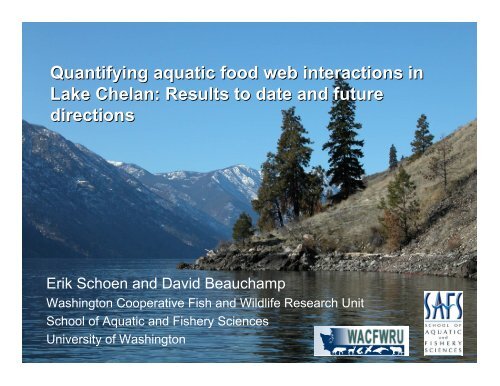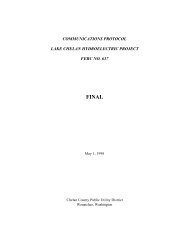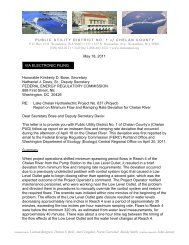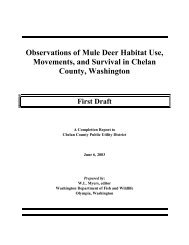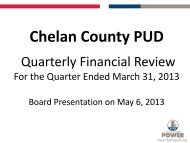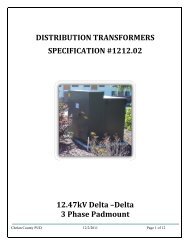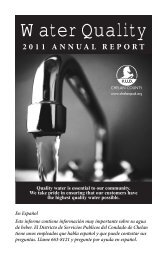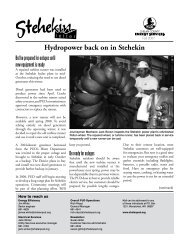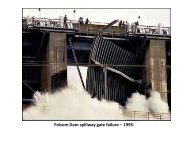Quantifying aquatic food web interactions in Lake Chelan ...
Quantifying aquatic food web interactions in Lake Chelan ...
Quantifying aquatic food web interactions in Lake Chelan ...
Create successful ePaper yourself
Turn your PDF publications into a flip-book with our unique Google optimized e-Paper software.
<strong>Quantify<strong>in</strong>g</strong> <strong>aquatic</strong> <strong>food</strong> <strong>web</strong> <strong><strong>in</strong>teractions</strong> <strong>in</strong><br />
<strong>Lake</strong> <strong>Chelan</strong>: Results to date and future<br />
directions<br />
Erik Schoen and David Beauchamp<br />
Wash<strong>in</strong>gton Cooperative Fish and Wildlife Research Unit<br />
School of Aquatic and Fishery Sciences<br />
University of Wash<strong>in</strong>gton
<strong>Lake</strong> <strong>Chelan</strong><br />
9 th deepest lake <strong>in</strong> the world (453 m)<br />
Lucerne Bas<strong>in</strong><br />
Over 80 km long<br />
Ultraoligotrophic<br />
Composed of two bas<strong>in</strong>s<br />
Wapato Bas<strong>in</strong>
Littoral<br />
Pelagic<br />
Profundal<br />
Deep Lucerne Bas<strong>in</strong><br />
Littoral<br />
Pelagic<br />
Profundal<br />
Shallow Wapato Bas<strong>in</strong>
Top<br />
Predators<br />
Native<br />
Bull trout (extirpated)<br />
Burbot<br />
Westslope cutthroat<br />
trout (collapsed)<br />
Northern pikem<strong>in</strong>now<br />
Introduced<br />
<strong>Lake</strong> trout<br />
Ch<strong>in</strong>ook salmon<br />
(collapsed)<br />
Smallmouth bass<br />
Ra<strong>in</strong>bow trout<br />
(no longer stocked)<br />
Planktivores<br />
& Primary<br />
Consumers<br />
Sculp<strong>in</strong>s<br />
Three-sp<strong>in</strong>e<br />
stickleback<br />
Suckers<br />
Kokanee<br />
Mysis relicta shrimp
Top<br />
Predators<br />
Native<br />
Burbot<br />
Westslope cutthroat<br />
trout (collapsed)<br />
Northern pikem<strong>in</strong>now<br />
Introduced<br />
<strong>Lake</strong> trout<br />
Ch<strong>in</strong>ook salmon<br />
(collapsed)<br />
Smallmouth bass<br />
Planktivores<br />
& Primary<br />
Consumers<br />
Kokanee<br />
Mysis relicta shrimp
<strong>Lake</strong> <strong>Chelan</strong> kokanee thrive after lake<br />
trout and Mysis become established<br />
Sources: WDFW stock<strong>in</strong>g records, <strong>Chelan</strong> PUD 2005, Brown 1984, DES 2000
Predation on salmonids<br />
What are the major predators of salmonids<br />
<strong>in</strong> the lake<br />
Especially<br />
Kokanee<br />
Cutthroat trout<br />
Ch<strong>in</strong>ook<br />
Is predation currently a major limit<strong>in</strong>g factor<br />
for kokanee
Photo: Mart<strong>in</strong> Grassley
<strong>Lake</strong> trout diet<br />
• All size classes of<br />
lake trout ate<br />
large proportions<br />
of Mysis <strong>in</strong><br />
shallow Wapato<br />
Bas<strong>in</strong><br />
• Only the smallest<br />
lake trout ate<br />
substantial<br />
amounts of Mysis<br />
<strong>in</strong> deep Lucerne<br />
Bas<strong>in</strong><br />
• Prelim<strong>in</strong>ary<br />
stable isotope<br />
results show<br />
same pattern
<strong>Lake</strong> depth may control<br />
vulnerability of Mysis to lake trout<br />
Deep Lucerne Bas<strong>in</strong><br />
Shallow Wapato Bas<strong>in</strong>
Northern<br />
pikem<strong>in</strong>now diet<br />
• All size classes ate<br />
mostly <strong>in</strong>vertebrates<br />
• The largest<br />
pikem<strong>in</strong>now ate<br />
significant numbers<br />
of salmonids <strong>in</strong><br />
Wapato Bas<strong>in</strong><br />
• Good news for<br />
salmonids:<br />
Pikem<strong>in</strong>now ate<br />
almost no salmonids<br />
<strong>in</strong> Lucerne Bas<strong>in</strong>
Burbot diet<br />
• Burbot are not a<br />
major salmonid<br />
predator<br />
• Burbot may be a<br />
significant<br />
predator of<br />
Mysis
Growth<br />
Consumption = + Metabolism<br />
+ Waste<br />
Bioenergetics<br />
Model
<strong>Lake</strong> trout age and growth<br />
• Ages determ<strong>in</strong>ed<br />
from opercles<br />
(Sharp and Bernard 1988)<br />
• Growth rate<br />
calculated from<br />
length-at-age<br />
and weight-atlength<br />
curves<br />
Weight (g)<br />
12000<br />
10000<br />
8000<br />
6000<br />
4000<br />
2000<br />
<strong>Lake</strong> trout weight at length<br />
Wapato<br />
Lucerne<br />
0<br />
150 250 350 450 550 650 750 850 950<br />
Fork length (mm)
<strong>Lake</strong> trout survival and population size<br />
• Survival rate determ<strong>in</strong>ed<br />
from age frequency of<br />
catch (Z ≈ 0.55, annual<br />
survival ≈ 58%)<br />
• Estimated annual<br />
harvest <strong>in</strong> Wapato Bas<strong>in</strong><br />
= 2000 to 3000 (A. Jones, pers.<br />
comm.)<br />
• Estimated m<strong>in</strong>imum age<br />
vulnerable to harvest at<br />
3.5 years (fork length =<br />
372 mm or 14 1/2”)<br />
• Population size<br />
estimated us<strong>in</strong>g Baranof<br />
catch equation (Shuter et al. 1998)<br />
Z<br />
− M<br />
Z<br />
−( Z )<br />
Catch<br />
t<br />
= (1 − e )<br />
where<br />
Z is the total mortality rate<br />
M is the natural mortality rate<br />
N t<br />
is the population at time t<br />
N<br />
Prelim<strong>in</strong>ary estimated<br />
size of Wapato Bas<strong>in</strong><br />
population<br />
= 13,959 to 20,939 lake<br />
trout (exclud<strong>in</strong>g age 0)<br />
t
<strong>Lake</strong> trout populationlevel<br />
consumption
<strong>Lake</strong> trout populationlevel<br />
consumption:<br />
fish only<br />
Salmonid prey difficult<br />
to identify by bones:<br />
about half are<br />
kokanee, rest are<br />
mostly unidentified<br />
Under this scenario,<br />
annual lake trout<br />
consumption<br />
= 3,400 kg salmonids<br />
= 92,000 age 1<br />
kokanee
Predation on salmonids:<br />
Conclusions<br />
<strong>Lake</strong> trout are a major predator on<br />
salmonids <strong>in</strong> both lake bas<strong>in</strong>s. We have<br />
the tools to quantify their current<br />
predation impact on kokanee.<br />
Northern pikem<strong>in</strong>now may also be an<br />
important predator, <strong>in</strong> the Wapato Bas<strong>in</strong><br />
only. No other species currently eats<br />
many salmonids
Competition for zooplankton<br />
Do Mysis compete with kokanee for <strong>food</strong><br />
1. How many Mysis and kokanee are <strong>in</strong> each<br />
lake bas<strong>in</strong><br />
2. How many zooplankton does each <strong>in</strong>dividual<br />
eat<br />
3. How many zooplankton are produced <strong>in</strong> the<br />
lake and available to planktivores
Kokanee abundance and zooplankton<br />
consumption<br />
Estimate abundance by two methods:<br />
• Hydroacoustic surveys<br />
• Age-structured population model based on<br />
the number of kokanee surviv<strong>in</strong>g to spawn<br />
For kokanee and Mysis:<br />
Estimate consumption<br />
demand with bioenergetics<br />
models<br />
(Beauchamp et al. 1989, Chipps and<br />
Bennett 2002)
Estimat<strong>in</strong>g abundance, distribution, and<br />
migration patterns of kokanee and<br />
Mysis<br />
Thermocl<strong>in</strong>e
Mysis sampl<strong>in</strong>g<br />
Zooplankton<br />
sampl<strong>in</strong>g
Mysis abundance and distribution<br />
Flathead<br />
<strong>Lake</strong><br />
mean<br />
Mysis<br />
density
Competition for<br />
zooplankton<br />
• Zooplankton<br />
production<br />
dom<strong>in</strong>ated Mysis<br />
and kokanee<br />
consumption<br />
dur<strong>in</strong>g most<br />
periods<br />
• Lucerne Bas<strong>in</strong><br />
had near-zero<br />
production dur<strong>in</strong>g<br />
w<strong>in</strong>ter
Do Mysis and kokanee compete for <strong>food</strong><br />
Possibly, but only <strong>in</strong> Lucerne Bas<strong>in</strong><br />
Kokanee<br />
Mysids<br />
Zooplankton<br />
In deep Lucerne Bas<strong>in</strong>, zooplankton productivity<br />
is low enough dur<strong>in</strong>g w<strong>in</strong>ter that kokanee may<br />
be <strong>food</strong> limited<br />
Next step: compare vertical distribution of<br />
zooplankton and consumers
Do Mysis enhance predation impact of<br />
lake trout Likely <strong>in</strong> Wapato Bas<strong>in</strong><br />
<strong>Lake</strong> trout<br />
Kokanee<br />
Mysids<br />
• <strong>Lake</strong> trout CPUE is 10x higher <strong>in</strong> shallow<br />
Wapato Bas<strong>in</strong> where mysids are the major prey<br />
• <strong>Lake</strong> trout have higher relative weight<br />
(“plumpness”) <strong>in</strong> Wapato Bas<strong>in</strong><br />
• When kokanee are available dur<strong>in</strong>g the spr<strong>in</strong>g,<br />
lake trout switch prey and eat them
Cutthroat trout and Ch<strong>in</strong>ook<br />
• No cutthroat or Ch<strong>in</strong>ook were<br />
positively identified <strong>in</strong> predator<br />
stomachs, but could be unidentified<br />
salmonid prey<br />
• Only 6 wild cutthroat trout and 5<br />
Ch<strong>in</strong>ook caught dur<strong>in</strong>g the study,<br />
all <strong>in</strong> Lucerne Bas<strong>in</strong><br />
• Pend<strong>in</strong>g stable isotope analysis will<br />
give general <strong>in</strong>dication of diet–<br />
anglers contributed additional<br />
samples<br />
• Can address predator-prey<br />
consequences of about future<br />
management actions us<strong>in</strong>g visual<br />
forag<strong>in</strong>g framework
FUTURE RESEARCH OPPORTUNITIES<br />
Visual forag<strong>in</strong>g framework: based on behavior of pelagic fish<br />
Search Volume & Prey Density <strong>in</strong>teract to determ<strong>in</strong>e<br />
predation rates
FUTURE RESEARCH OPPORTUNITIES<br />
Visual forag<strong>in</strong>g applications for <strong>Lake</strong> <strong>Chelan</strong> management:<br />
Cutthroat trout recovery<br />
Do current lake trout densities<br />
preclude recovery of cutthroat trout<br />
How much enhancement by stock<strong>in</strong>g<br />
is necessary to overcome predation<br />
losses<br />
How would predation pressure change<br />
under different densities of lake trout<br />
or Ch<strong>in</strong>ook<br />
Ch<strong>in</strong>ook salmon rebuild<strong>in</strong>g<br />
Do current lake trout densities<br />
preclude rebuild<strong>in</strong>g a Ch<strong>in</strong>ook<br />
population<br />
Are recent kokanee densities high<br />
enough to support Ch<strong>in</strong>ook At<br />
what Ch<strong>in</strong>ook density
FUTURE RESEARCH OPPORTUNITIES<br />
Ref<strong>in</strong><strong>in</strong>g exist<strong>in</strong>g diet data<br />
Genetic ID of unidentified salmonid prey: 40<br />
stomachs conta<strong>in</strong>ed salmonids. Of these, 20<br />
conta<strong>in</strong>ed unidentified salmonids, 19 conta<strong>in</strong>ed<br />
kokanee, and 2 conta<strong>in</strong>ed lake trout.<br />
Analysis of littoral diet samples<br />
collected <strong>in</strong> Wapato Bas<strong>in</strong><br />
by electroshock<strong>in</strong>g and gill<br />
nett<strong>in</strong>g by WDFW (n = 197)<br />
Bioenergetics model<strong>in</strong>g for<br />
pikem<strong>in</strong>now (or bass)
FUTURE RESEARCH OPPORTUNITIES<br />
Evaluat<strong>in</strong>g alternative stock<strong>in</strong>g strategies<br />
How many stocked<br />
fish are consumed<br />
immediately after<br />
stock<strong>in</strong>g<br />
Pilot study <strong>in</strong> 2005 found<br />
major lake trout<br />
predation response to<br />
kokanee stock<strong>in</strong>g<br />
Can alternative stock<strong>in</strong>g<br />
strategies reduce this<br />
loss<br />
Stock<strong>in</strong>g at night In<br />
Lucerne Bas<strong>in</strong> Other<br />
ideas
Acknowledgements<br />
Fund<strong>in</strong>g: USGS, UW SAFS, <strong>Lake</strong> <strong>Chelan</strong> Sportsmen’s<br />
Association<br />
Nathanael Overman, Anna Buettner, Chris Sergeant, Mart<strong>in</strong> Grassley,<br />
Liz Duffy, Jen McIntyre, Er<strong>in</strong> Lowery, Mike Mazur, Susan Wang,<br />
Sarah McCarthy, Brittany Long, Cara Menard, Neala Kendall, Evelyn<br />
Cheng, Jared Mitts, and Neil Jones<br />
Frank and Patricia Clark, Anton and Sandy Jones, and Joe He<strong>in</strong>len<br />
Phil Archibald, Mallory Lenz, Robert Sheehan, and US Forest Service<br />
Art Viola, Matt Polacek and WDFW<br />
Reed Glesne, Vicki Gempko, and NPS<br />
Jeff Osborn and <strong>Chelan</strong> PUD<br />
<strong>Lake</strong> <strong>Chelan</strong> Fish Hatchery
Questions
Annual mean Mysis densities<br />
Deep Lucerne<br />
Bas<strong>in</strong><br />
Shallow<br />
Wapato Bas<strong>in</strong><br />
1<br />
2<br />
3<br />
4 5
Mysis<br />
planktivory<br />
• Cladoceran<br />
stand<strong>in</strong>g stock<br />
biomass was far<br />
greater than<br />
seasonal Mysis<br />
consumption<br />
dur<strong>in</strong>g most<br />
periods<br />
• Mysis<br />
consumption may<br />
limit Daphnia<br />
densities <strong>in</strong> deep<br />
Lucerne Bas<strong>in</strong><br />
dur<strong>in</strong>g cold<br />
months (caveats)
<strong>Lake</strong> trout diet: August<br />
Wapato Bas<strong>in</strong><br />
<strong>Lake</strong> trout diet composition: Wapato Bas<strong>in</strong>, August/September<br />
n = 6 n = 11 n = 5<br />
100%<br />
Percent of stomach<br />
contents by weight<br />
80%<br />
60%<br />
40%<br />
20%<br />
0%<br />
180-390 391-450 451-530 531-850<br />
<strong>Lake</strong> trout diet composition: Bas<strong>in</strong>, August/September<br />
Lucerne Fork length (mm)<br />
n = 1 n = 2 n = 2<br />
100%<br />
Percent of stomach<br />
contents by weight<br />
80%<br />
60%<br />
40%<br />
20%<br />
0%<br />
180-390 391-450 451-530 531-850<br />
Fork length (mm)
<strong>Lake</strong> trout diet: February<br />
100%<br />
<strong>Lake</strong> trout diet composition: Wapato Bas<strong>in</strong>, February<br />
Wapato Bas<strong>in</strong><br />
n = 1 n = 5 n = 15 n = 6<br />
Percent of stomach<br />
contents by weight<br />
80%<br />
60%<br />
40%<br />
20%<br />
0%<br />
100%<br />
180-390 391-450 451-530 531-850<br />
<strong>Lake</strong> trout diet composition: Lucerne Bas<strong>in</strong>, February<br />
Lucerne Fork length (mm)<br />
n = 1 n = 9 n = 4<br />
Percent of stomach<br />
contents by weight<br />
80%<br />
60%<br />
40%<br />
20%<br />
0%<br />
180-390 391-450 451-530 531-850<br />
Fork length (mm)
<strong>Lake</strong> trout<br />
Kokanee<br />
Mysids<br />
Zooplankton


